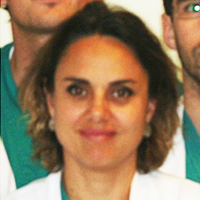Nanometer-scale distribution of PD-1 in the melanoma tumor microenvironment
Published on: 10th May, 2023
The nanometer-scale spatial organization of immune receptors plays a role in cell activation and suppression. While the connection between this spatial organization and cell signaling events is emerging from cell culture experiments, how these results translate to more physiologically relevant settings like the tumor microenvironment remains poorly understood due to the challenges of high-resolution imaging in vivo. Here we perform super-resolution immunofluorescence microscopy of human melanoma tissue sections to examine the spatial organization of the immune checkpoint inhibitor programmed cell death 1 (PD-1). We show that PD-1 exhibits a variety of organizations ranging from nanometer-scale clusters to more uniform membrane labeling. Our results demonstrate the capability of super-resolution imaging to examine the spatial organization of immune checkpoint markers in the tumor microenvironment, suggesting a future direction for both clinical and immunology research.
COVID-19 detection and classification: key AI challenges and recommendations for the way forward
Published on: 25th May, 2023
Coronavirus disease (COVID-19) is a viral pneumonia that is found in China and has spread globally. Early diagnosis is important for effective and timely treatment. Thus, many ongoing studies attempt to solve key COVID-19 problems such as workload classification, detection, and differentiation from other pneumonia and healthy lungs using different imaging modalities. Researchers have identified some limitations in the deployment of deep learning methods to detect COVID-19, but there are still unmet challenges to be addressed. The use of binary classifiers or building classifiers based on only a few classes is some of the limitations that most of the existing research on the COVID-19 classification problem suffers from. Additionally, most prior studies have focused on model or ensemble models that depend on a flat single-feature imaging modality without using any clinical information or benefiting from the hierarchical structure of pneumonia, which leads to clinical challenges, and evaluated their systems using a small public dataset. Additionally, reliance on diagnostic processes based on CT as the main imaging modality, ignoring chest X-rays. Radiologists, computer scientists, and physicians all need to come to an understanding of these interdisciplinary issues. This article first highlights the challenges of deep learning deployment for COVID-19 detection using a literature review and document analysis. Second, it provides six key recommendations that could assist future researchers in this field in improving the diagnostic process for COVID-19. However, there is a need for a collective effort from all of them to consider the provided recommendations to effectively solve these issues.
Using Model Classification to detect Bias in Hospital Triaging
Published on: 12th June, 2023
Background: In light of the COVID-19 pandemic and the health crisis left in its wake, our goal is to develop extensive machine-learning techniques to provide a clear picture of the treatment, and possible mistreatment, of specific patient demographics during hospital triaging.Objective: We aim to reveal whether a patient’s treatment and hospital disposition is related to the following attributes - Emergency Severity Index (ESI), gender, employment status, insurance status, race, or ethnicity which our 100 MB dataset included.Materials and methods: Our work is separated into two parts - the classification task and data analysis. As part of the classification task, we used the k-Nearest-Neighbor classifier, the F1-score, and a random forest. We then analyze the data using SHapley Additive exPlanations (SHAP) values to determine the importance of each attribute.Results: Our findings show that significance varies for each attribute. Notably, we found that patients with private insurance programs receive better treatment compared to patients with federal-run healthcare programs (e.g. Medicaid, Medicare). Furthermore, a patient’s ethnicity has a greater impact on treatment for patients under 40 years of age for any given ESI level. Surprisingly, our findings show language is not a barrier during treatment.Discussion and conclusion: We, therefore, conclude that although hospitals may not be doing so intentionally, there is a systemic bias in hospital triaging for specific patient demographics. For future works, we hope to aggregate additional patient data from hospitals to find whether specific demographics of patients receive better healthcare in different parts of the United States.
The Role of Advanced Imaging in Paediatric Cardiology: Basic Principles and Indications
Published on: 24th June, 2023
Tissue Doppler Imaging and Speckle Tracking Echocardiography are newer echo-cardiographic modalities, that assess myocardial and valvular function in congenital and acquired heart diseases in childhood. In addition, cross-sectional imaging including Cardiac Magnetic Resonance (CMR) and Cardiac Computed Tomography has been widely used over the last decade in paediatric cardiology, in order to evaluate intra-cardiac and extra-cardiac anatomy. Cardiac Magnetic Resonance particularly allows detailed analysis of myocardial function, and shunt quantification and has applications even in fetal life. This mini-review summarizes the basic principles of the above-advanced modalities and highlights their main indications and clinical applications in childhood.
Harnessing Artificial Intelligence for Early and Evolution of Alzheimer’s Disease Detections and Enhancing Senior Mental Health through Innovative Art-Singing Therapies: A Multidisciplinary Approach
Published on: 28th June, 2023
The well-documented therapeutic potential of group singing for patients living with Alzheimer’s disease (PLAD) has been hindered by COVID-19 restrictions, exacerbating loneliness and cognitive decline among seniors in residential and long-term care centers (CHSLDs). Addressing this challenge, the multidisciplinary study aims to develop a patient-oriented virtual reality (XR) interaction system facilitating group singing for mental health support during confinement and enhancing the understanding of the links between Alzheimer’s disease, social interaction, and singing. The researchers also propose to establish an early AD detection system using voice, facial, and non-invasive biometric measurements and validate the efficacy of selected intervention practices. The methodology involves co-designing an intelligent environment with caregivers to support PLAD mental health through online group singing, addressing existing constraints in CHSLDs. The researchers will engage volunteers in remote singing interactions and validate the impact of voice stimulation for PLADs using a control group. The primary expected outcome is the development of an “Intelligent Learning Health Environment,” fostering interactions while adapting to individual PLAD situations and incrementally accumulating knowledge on AD signs. This environment will facilitate the transfer of knowledge and technologies to promote non-verbal interactions via singing, enabling intervention at the first symptoms. Additionally, the research will contribute to transforming CHSLDs’ living environments, informed by neuroscience insights, and potentially extend the “collaborative self-care” approach to support seniors in aging safely and healthily at home.
Sudden Cardiac Death in a Neonate Due to Bilateral Absence of Coronary Artery Ostium
Published on: 24th July, 2023
Introduction: Congenital heart disease is a leading cause of neonatal mortality linked to birth defects. Despite the widespread availability of prenatal screenings, detection rates remain low. Accurate early detection of these lesions is pivotal to reducing neonatal morbidity and mortality.Methods: In this case, we present a neonate who experienced sudden cardiac death due to a rare, undiagnosed congenital cardiac anomaly - the bilateral absence of coronary artery ostium. Discussion: This case highlights the importance of prenatal detection of congenital cardiac anomalies. While fetal echocardiography is frequently utilized, it only identifies CHD in 36-50% of cases. This is attributed to inadequate imaging procedures, varied operator skills, and regional discrepancies. Early detection of severe CHD is essential for specialized treatment, thereby mitigating neonatal health risks and improving survival rates.Conclusion: Prenatal detection of CHD, especially coronary anomalies, continues to pose significant challenges. There is a pressing need to establish and enforce standardized protocols for fetal echocardiography aimed at these anomalies. To enhance care and improve outcomes, a joint effort between academic institutions and community centers is encouraged.Learning Objectives: • Congenital coronary artery anomalies are a significant cause of sudden cardiac death in children.• The absence of a coronary artery ostium is known to be associated with other congenital heart diseases, particularly pulmonary atresia with an intact ventricular septum. However, isolated coronary disease has also been reported in this case.• Prenatal echocardiography is a valuable tool for diagnosing congenital heart disease. However, certain limitations may be encountered when diagnosing coronary artery anomalies.
Magnets, Gradients, and RF Coils of MR Scanners
Published on: 25th July, 2023
The topic of this paper is the parts of modern MR devices, which contain magnet coils. MR scanner magnets are made of four types of electromagnetic coils: 1) Main magnet, made of superconducting material. The main magnet of an MR (Magnetic Resonance Imaging) scanner creates a strong and uniform magnetic field around the patient being scanned. This magnetic field is typically in the range of 0.5 to 3 Tesla and is used to align the magnetic moments of the hydrogen atoms in the patient's body. The superconductors, which create the main magnetic field, should be cooled with liquid helium and liquid nitrogen. The main magnets made of superconductors should use a cryostat, with cooling vessels with liquid helium and liquid nitrogen, thermal insulation, and other protective elements of the magnet system. 2) The gradient magnetic field is made of three types of coils: x-coils, y-coils, and z-coils. The X coil, made of resistive material, creates a variable magnetic field, horizontally, from left to right, across the scanning tube; 3) The Y coil creates a variable magnetic field, vertically, from bottom to top; 4) The Z coil creates a variable magnetic field, longitudinally, from head to toe, inside the scanning tube. RF coils are used to generate RF pulses to excite the hydrogen protons (spins) in the patient's body and detect the signals emitted by the protons when they return to their equilibrium state after the RF excitation is turned off. The resulting interaction between the magnetic field and the aligned hydrogen atoms produces a signal that is used to generate the images seen in an MRI scan. The main magnetic field is what allows MR imaging to produce detailed anatomical and functional information non-invasively. The structure of the MR scanner magnet is complex. The resonant frequency changes at each point of the field in a controlled manner. Inside the copper core are embedded the windings of the main magnet made of superconducting material in the form of microfibers. A non-linear gradient field is created by coils of conductive material. It adds to the main magnetic field. Thus the resulting magnetic field is obtained. The types of magnets that exist in the basic configurations of MR scanners are analyzed. Scanners in the form of a closed cylindrical cavity generate their magnetic fields by passing current through a solenoid, which is maintained at the temperature of a superconductor. Exclusively used superconductors are niobium-titanium (NbTi), niobium-tin (Nb3Sn), vanadium-gallium (V3Ga), and magnesium-diboride (MgB2). Only magnesium diboride is a high-temperature superconductor, with a critical temperature Tc = 390K. The three remaining superconductors are low temperatures. New high-temperature superconductors have been discovered, as well as superconductors at room temperature. Newly discovered superconducting materials are not used in MR scanners.
Psychosis in Parkinson’s Disease and Current Management Trends- an Updated Review of Literature
Published on: 26th July, 2023
As a neurodegenerative disorder, Parkinson’s disease (PD) is characterized by a combination of premotor, motor, and nonmotor symptoms. PD is commonly accompanied by psychosis, which is one of the commonest symptoms in the long run. As a result of Parkinson’s disease psychosis (PDP), symptoms can range from minor consequences of the disease (illusions, passage hallucinations, and presence hallucinations), to visual and nonvisual hallucinations and delusions. PDP is associated with a reduction in function and a reduction in quality of life as well. It is commonly believed that PDP is related to economic burden, and it has a significant impact on the utilization of long-term care services. The main focus should be on diagnosing, classifying, and managing PDP in an appropriate manner. As a first step in the management of PDP patients, the emphasis should be on identifying and treating any contributing medical factors, reducing or discontinuing medications that could cause or worsen psychosis, as well as nonpharmacological strategies and considering acetylcholinesterase inhibitors for treatment when dementia is present. A number of medications are being considered for use in PDP, including pimavanserin, quetiapine, and clozapine. The purpose of the current review is to provide a comprehensive understanding of the disorder in the general population with PD, including epidemiology, psychotic symptoms, risk factors, triggers, neuro-signaling pathways, diagnosis, and treatment of PDP.
Myxedema Coma and Acute Respiratory Failure in a Young Child: A Case Report
Published on: 26th July, 2023
Background: Myxedema is an extreme manifestation seen in patients with untreated hypothyroidism. It is a lethal endocrine emergency, which arises when a precipitating cause overwhelms the compensatory mechanisms of the hypothyroid state.Objectives: This case report aims to present a case of myxedema coma secondary to cretinism. It also aims to discuss how hypothyroidism leads to hypoventilation and eventually respiratory failure, as well as to discuss the epidemiology, pathophysiology, clinical manifestation, diagnosis, and management of a child with myxedema coma.Case presentation: This is a case of a 7-year-old female, diagnosed with congenital hypothyroidism at 5 months of age, but eventually was lost to follow-up. She came back after 7 years presenting with difficulty of breathing. She was seen hypothermic, obtunded, and in severe respiratory distress. She was severely stunted and underweight with coarse facial features. Initial laboratory work-up showed elevated Thyroid Stimulating Hormone (TSH) as well as decreased tri-iodothyronine (FT3) and thyroxine (FT4). She was immediately started on levothyroxine, with noted resolution of the edema and improvement in sensorium. There was also noted improvement in the patient’s ventilation and was sent home on Continuous Positive Airway Pressure (CPAP) while asleep.Conclusion: This case highlights the importance of having a high index of suspicion of its clinical manifestations, which could lead to earlier intervention thereby preventing further complications. A multidimensional approach is essential in managing this case, as various organ systems are involved in this condition.
latrogenic Pneumothorax Caused by Thoracic Puncture Secondary to Anti-aging Medicine
Published on: 27th July, 2023
Introduction: Pneumothorax is defined as air in the pleural cavity, the iatrogenic cause happens after invasive procedures as thoracic needle aspiration, central line placement, pacemaker placement, etc. Nevertheless, it is possible to be found in non-medical procedures, such as alternative medicine, more specifically acupuncture. There are medications used against aging that FDA has warned to be used only in its first objective, an example is procaine hydrochloride.Case: A 63 y/o female, Mexico City resident, with anxiety, came to a follow-up appointment for an aging cohort, where CT, PFT, and laboratories are made for pulmonary healthy subjects to investigate normal lung aging and how other environmental factors can affect the lungs; at physical examination, we did not find any pleuropulmonary syndrome, but in the CT a left Iatrogenic pneumothorax was found; we re-asked for antecedents and she described that 15 days before the date she had 2 punctures in the middle clavicular line to apply procaine hydrochloride as an anti-aging treatment.Discussion: There is diverse evidence of adverse effects associated with acupuncture, and even if pneumothorax has a small percentage of incidence, in some cases it can be severe and can even cause fatalities.Conclusion: The pneumothorax in this case was iatrogenic due to the thoracic puncture for an anti-aging treatment, with a total resolution with conservative treatment, however we as health professionals have the responsibility to inform our patients that initiatives of administration ways can cause important complications.
Conservation Threats to Ethnomedicinal plants in Kore District, South Eastern, Ethiopia
Published on: 4th August, 2023
The study aimed to investigate the threats to the biodiversity of ethnomedicinal plants and to find consensus information on conservation and management practices of ethnomedicinal plants to contribute sustainable utilization of ethnomedicinal plants in Kore district, Southeastern Ethiopia. The result of the survey revealed that sixty-one medicinal plants were reported by the informants from the study area. These plants are distributed in 59 genera and 37 families. Family Lamiaceae and Asteraceae were represented by 5 (8.2%) species for each family and this is the highest number of species and followed by 4 (6.5%) species of Solanaceae and Fabaceae for each family. Preference ranking analysis shows that Eucalyptus globulus scored 47, indicating that it is the most used plant for firewood in the community, followed by Olea europaea (45) and the least used plant for firewood is Juniperus procera scored 36. Paired comparison analysis showed that Olea Europeae ranked first followed by Podocarpus falcatus for the use of charcoal production in the study area. The major purposes of plant species in the study area were construction, Charcoal, Firewood, Furniture, and Fences as well as for medicinal uses. Based on direct matrix ranking analysis Juniperus procera, Eucalyptus globulus, Podocarpus falactus, Olea europaea, Hagenia abyssinica, Croton macrostachyus, and Cordia africana were the most preferred medicinal plants by local people in the study area. The analysis's findings indicated that anthropogenic influences are endangering medicinal plants. In this study area, only about 13% of medicinal plants are collected from home gardens. This shows that the effort made by the community to conserve medicinal plants is not satisfactory. Therefore, encouraging NGOs and Government offices to participate in the conservation of medicinal plants to encourage the local people to plant indigenous trees for domestic use is necessary.
Evaluation of Preoperative Cardiology Consultations: Incidence, Characteristics and Implications for Perioperative Management
Published on: 14th August, 2023
Background: This retrospective study examines the importance of preoperative cardiology consultations in optimizing patient care and anesthesia surgical perioperative management.Methods: The study includes 7,756 patients from the Department of Anesthesiology at Mohammed V Military Teaching Hospital. Out of these, 122 patients were referred to cardiology consultations. Demographics, surgical specialties, reasons for referral, diagnostic tests, and interventions were analyzed.Results: Referred patients (average age 61.45 years) were mainly over 65 years old, with 59.01% being male. Common surgical specialties seeking consultations were abdominal surgery (30.327%), orthopedic surgery (26.230%), and urological surgery (19.672%). Hypertension, dyslipidemia, and diabetes were prevalent risk factors. Most patients were classified as ASA II (50%) or ASA III (27.04%), with NYHA I (61.5%) or NYHA II (31.2%) classifications. Referrals were due to ECG abnormalities (41.0%), routine evaluation (19.7%), and history of myocardial infarction or previous coronary angiography (39.3%).Discussion: Preoperative cardiology consultations accounted for 1.57% of all pre-anesthesia clinic patients. They were vital in assessing and managing cardiovascular risks, consistent with previous studies. The impact of these consultations was evident in optimizing patient management through treatment plan adjustments and interventions.Conclusion: Preoperative cardiology consultations play a crucial role in identifying and managing cardiovascular risks, contributing significantly to patient care and improving perioperative management. Further research should evaluate long-term outcomes and cost-effectiveness across different patient populations.
Retroperitoneal Bronchogenic Cyst: Imaging and Pathophysiological Review
Published on: 22nd August, 2023
Bronchogenic cysts are rare lesions that form during early embryogenesis and are commonly located in the mediastinum. Retroperitoneally located bronchogenic cysts are an exceptionally rare entity. These are most commonly found incidentally on imaging. We will review the unique imaging and histopathological findings of this entity and discuss why prophylactic surgery is considered the treatment of choice. By reviewing retroperitoneal bronchogenic cysts, we aim to educate clinicians regarding the presentation, investigations, imaging characteristics, and treatment of this exceeding rare entity.
Synergistic Approach: Photobiomodulation, Neuromodulation, and Drug Therapy in Neuropsychiatry. A Promising Strategy to Enhance PBM Adoption and Neurotherapy Efficacy
Published on: 18th August, 2023
Photobiomodulation (PBM) is an effective method for treating neuropsychiatric diseases, yet its universal acceptance and utilization remain constrained. In this Letter to the Editor/Expert Opinion, we address the challenges confronting PBM researchers and pioneers, striving to establish universal confidence in its exclusive application for neuropsychiatric patient care. Despite encouraging animal experiments and selecting positive human clinical trial outcomes, PBM’s widespread acceptance of PBM is hindered by factors including limited clinical studies and clashes with established therapies, such as drug therapy and psychotherapy.To overcome these obstacles and broaden PBM’s adoption and application of PBM in neuropsychiatry, we propose a combinatorial therapy approach. By integrating PBM with interventions such as Cognitive Behavioral Therapy (CBT) or drug therapy, a cumulative effect can be attained, benefiting both patients and therapists. Patients gain access to diverse treatment options and experience synergistic effects of combined therapies, thereby enhancing outcomes. Therapists benefit from expanded intervention choices and improved quality of patient care.This study introduces a novel strategy of amalgamating PBM with recognized interventions, such as CBT and drug therapy, to address existing challenges. This combined approach offers a practical solution to augment PBM acceptance and usage in the realm of neuropsychiatry.To endorse this strategy, a shift in the research direction is imperative. Future studies should investigate the amalgamated use of PBM with other neurointerventions, such as CBT or drug therapy. Robust clinical trials contrasting groups like “PBM + CBT” and “PBM (sham) + rTMS” are vital to persuade clinicians and patients toward embracing combined PBM therapies.Although PBM’s eventual autonomy as a neuropsychiatric treatment is an overarching goal, the present combination therapy approach proves practical, inevitable, and mutually beneficial. By bridging conventional therapies with PBM, this strategy may facilitate wider acceptance and utilization in neuropsychiatry.
Update in the Understanding, Diagnosis, and Management of Sturge Weber Syndrome: Case Report
Published on: 24th August, 2023
Sturge-Weber Syndrome (SWS) is a congenital, vascular, neurocutaneous, uncommon disease associated with facial angiomas port wine birthmark (PWB) or “nevus flammeus”, cerebral vascularity alterations (leptomeningeal vascular malformation), and ocular disorders. It is the third most common neurocutaneous syndrome after neurofibromatosis and tuberous sclerosis. GNAQ R183Q is the most frequent related mutation, caused by a postzygotic, somatic, gain-of-function. 75% of patients present seizures during the first year of life, mainly focal motor seizures, with or without consciousness impairment.We present the case of a 33-year-old female with a diagnosis of SWS, with refractory seizures that started at 4 months of age. In this admission, she presented upper and lower respiratory tract infections that culminated in a convulsive status epilepticus (CSE), the reason for which she required sedation and advanced airway management with adjustment of the anti-seizure medication (ASM). An electroencephalogram (EEG) was performed that reported epileptic activity, as well as an imaging study with data suggestive of calcification in the frontal and right parietal region, compatible with vascular malformation.
A Novel Strategy to Improve Radiotherapy Effectiveness: First-in-Human MR-guided Focused Ultrasound-Stimulated Microbubbles (MRgFUS+MB) Radiation Enhancement Treatment
Published on: 24th August, 2023
Background and aim: Preclinical in vitro and in vivo experiments suggest that radiation-induced tumour cell death can be enhanced 10- to 40-fold when combined with focused-ultrasound (FUS)-stimulated microbubbles (MB). The acoustic exposure of MB in the tumour volume causes vasculature perturbation, activation of the acid sphingomyelinase (ASMase) ceramide pathway, and resultant endothelial cell apoptosis. When the tumour is subsequently treated with radiation, there is increased endothelial cell death and anoxic tumour killing. Here we describe a first-in-human experience treating patients with magnetic resonance (MR)-guided FUS-stimulated MB (MRgFUS+MB) radiation enhancement.Case presentation: A head and neck cancer patient with recurrent disease underwent radiotherapy for 5 separate sites of locoregional disease followed by systemic therapy. The first consisted of a course of 45 Gy in 5 fractions alone, the second of 30 Gy in 5 fractions with hyperthermia, and the three others of 20-30 Gy in 5 fractions along with MRgFUS+MB treatment. The treatment methodology used an MR-coupled FUS-device operating at 500 KHz and 540 kPa peak negative pressure with an insonification time of 750 ms spread over 5 minutes to stimulate intravenously administered MB within tumour target. All sites treated with stimulated MB had a complete radiological response, and subsequently, the patient’s other cutaneous metastatic disease disappeared. The patient has been under surveillance for over two years without active treatment or disease progression.Discussion: MRgFUS+MB was well-tolerated with no reported treatment-related adverse events, which can be attributed to the capability of FUS to selectively stimulate MB within the tumour volume while sparing the surrounding normal tissue. Sustained local control at all target sites aligns with earlier preclinical findings suggesting the radiation enhancement potential of FUS+MB.Conclusion: MRgFUS+MB represents a novel and promising therapy for enhancing radiation efficacy and improving therapeutic index with potential improvements in disease control.
Pneumopericardium: A Rare Complication of Antireflux Surgery
Published on: 23rd August, 2023
Pneumopericardium is a rare clinical entity, occurring in the setting of thoracic trauma, malignancies, or mechanical ventilation. Very few cases report pneumopericardium as a complication of gastrointestinal tract surgery. Signs and symptoms may be frustrating, ranging from asymptomatic to chest pain, sepsis, hemodynamic instability, pericarditis, or even cardiac tamponade. Clinical pathognomonic signs of pneumopericardium include pericardial metallic tinkling friction rub and mill wheel murmur. Diagnostic work-up includes electrocardiogram, chest radiography, and, computed tomography imaging. A gastro pericardial fistula should be considered a rare differential diagnosis for acute chest pain in patients with a history of gastroesophageal surgery. Rapid recognition and treatment avoid life-threatening complications. The successful outcome of gastro pericardial fistula treatment depends on both emergency and definitive surgical management. The survival rate with conservative management is poor.We present the case of a 78-year-old patient suffering from pneumopericardium and pericardial infusion, due to a fibrotic fistula between the Nissen’s valve, occurring 10 years after redo antireflux surgery. Treatment included broad-spectrum antibiotics, and emergency surgery for pericardial drainage, biopsy of the valve’s defect, suture, and omentoplasty.
Faecal Transplant Therapy: A Promising Treatment Modality for Cardiovascular Diseases
Published on: 28th August, 2023
Cardiovascular diseases (CVD) are considered as “lifestyle” diseases and so far “No unified procedure” or medicines are effective in the management of this group of diseases. Researchers and clinicians have indicated that no safe therapeutic window is available in therapeutics at present. Recent research showed that gut microbiota are effective in managing lifestyle diseases therefore we introduced the influence of gut microbiota in the prognosis of the CVDs. Faecal transplant therapy(FMT) has been anticipated to treat many diseases similar to recurrent bacterial Clostridioides difficile infection which has been used worldwide. Recently, FMT was tried on an animal model to treat CVDs, and recent human trials that were tried to manage CVDs in humans by FMT showed encouraging results. The mechanism of action of transplanted bacteria to manage CVDs in the human population is also discussed. In-depth knowledge on the pros and cons of FMT will pave the way to standardize the procedure once the lacuna existing at present in treating CVDs, is paved, this technology will be useful for the masses.
Multiparametric MRI for the Assessment of Treatment Effect and Tumor Recurrence in Soft-tissue Sarcoma of the Extremities
Published on: 20th September, 2023
Soft-tissue sarcomas are a rare and complex group of malignant tumors. Advanced MRI sequences such as diffusion-weighted imaging (DWI) and perfusion-weighted imaging/dynamic contrast enhancement (PWI/DCE) can provide valuable tumor characterization and treatment response assessment. In the case of archetypical cellular tumors such as Pleomorphic Undifferentiated sarcoma (UPS), Good responders often display right-side displacement of the ADC intensity histogram, resulting in increased ADC-mean and decreased kurtosis and Skewness compared with Baseline and poor responders’ more left-sided curve. The PWI/DCE pattern most often associated with a good response is the presence of a “capsular-like” enhancement and a TIC type 2. Sarcoma hemorrhage patterns on SWI emerge during treatment, including “interstitial,” globular,” “luminal,” and incomplete and complete “peripheral ring-like” tumor wall hemosiderin impregnation. Treatment-induced bleeding is typically associated with low SWI-mean values and a left-sided intensity histogram with positive Skewness.During post-surgical surveillance, DCE MR imaging can reliably distinguish recurrent sarcoma from post-surgical scarring. TICs III, IV, and V raise the suspicion of local tumor recurrence, while TIC type II usually represents benign post-operative change such as granulation tissue. Advanced MRI is an essential tool for assessing sarcomas during and after therapy.
Hydrogel-Based Formulations for Drug Delivery to the Posterior Segment of the Eye
Published on: 12th September, 2023
Hydrogel-based formulations hold significant promise for treating ocular diseases that impact the posterior segment of the eye. These formulations exhibit the ability to surmount ocular barriers and offer sustained drug release, rendering them efficacious drug delivery systems. This article addresses the challenges linked to treating disorders affecting the posterior eye segment and underscores the imperative for less invasive drug delivery methodologies. We further delve into diverse contemporary ocular dosage forms, encompassing gels, nanostructures, and implants, with a specific emphasis on hydrogels. Hydrogels offer several merits, including precise targeting, sustained release, enhanced bioavailability, and non-invasiveness. Moreover, they curtail the risk of adverse effects and foster patient adherence. An enthralling advancement is the amalgamation of hybrid drug delivery systems, integrating nanoparticles, liposomes, dendrimers, and stimuli-activated nano-systems, with hydrogels for posterior eye ailment treatment. These hybrid nano-systems exhibit promise in enhancing drug stability, prolonging drug release, and pinpointing specific tissues within the posterior segment. We also provide an overview of ongoing clinical trials and approved hydrogel-based drug delivery systems, like Retisert and Ozurdex. These systems have demonstrated efficacy in managing chronic non-infectious uveitis, Age-related Macular Degeneration (AMD), and diabetic macular edema. Nevertheless, challenges persist, including optimizing bioavailability, maintaining drug stability, and implementing personalized treatment approaches. The incessant evolution of gel-based drug delivery systems stands to substantially enhance patients’ quality of life and establish new benchmarks in treating posterior eye diseases. The future of ophthalmology brims with excitement, as gel-based drug delivery systems hold the potential to revolutionize ocular therapies, providing effective remedies for an array of vision-related afflictions.
















